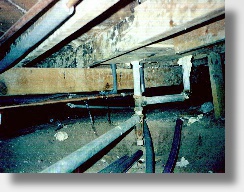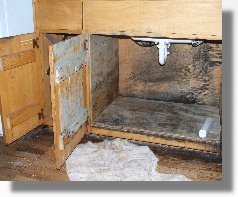ENVIRONMENTAL MICROBIOLOGY
CERL, Inc
ENVIRONMENTAL CONSULTANTS
MOLD
Mold is a common term used for fungi commonly found in our homes or buildings; however, while all 'molds' are fungi, not all
fungi are molds (confusing huh!). Fungi are one of the most ubiquitous life forms on earth and are found virtually everywhere.
There are no domestic or natural environments free of molds, fungi, yeasts or bacteria. The number of spores or organisms
present at any one time is dependent on humidity, soil moisture, temperature, sunshine (light), the presence and number of
plants, animals and/or organic materials in the area and much more. These microorganisms are generally beneficial or
necessary as part of the `cycle-of-life'. Without these microorganisms life on earth could not survive. Some are part of the
normal skin flora (inhabitants) on man, animals and plants. Some are used to process materials into products we use everyday,
such as bread, cheese, beer, soy sauce, antibiotics, medicines, etc. In short, man lives in a virtual sea of these microorganisms
and can never be free of their influence, good, bad, or indifferent.
Every surface we touch and every breath we take contains some level of spores and live microorganisms, some of which, under
the right circumstances, can produce adverse health effects. Dead or live these organisms, their waste products and/or, in some
cases, mold/fungi produced toxins (mycotoxins) are all quite capable of causing adverse health effects. The health effects in
humans can range from mild allergies to disabling and/or fatal diseases or poisonings. Keep in mind that it does NOT take a live
or viable mold/fungi to produce an adverse health effect. The first step in producing an adverse health effect is the amount of
exposure or ‘dose'. Each individual responds differently to the same ‘dose' of a microorganism or its by-products. A dose that
may cause a severe response in one individual may have virtually no effect on another. As mentioned, we are constantly
exposed to some level of microorganisms in the air we breathe and the things we touch. The world we live in has a naturally
occurring level that we are exposed to without suffering an adverse health effect. It is those situations where elevated exposure
occurs that problems can arise. The exposure level at which a health effect occurs is known as the ‘dose-response' level and is
generally different for each individual and mold type. This wide variability in human susceptibility to mold exposure has caused
considerable difficulty in attempts to date to set recommended exposure levels by various groups, associations and regulatory
agencies.
The problems associated with mold exposure has been long recognized and been traditionally addressed simply by considering
the presence of visible mold growth as an unsanitary condition whose causative condition and presence must be corrected.
While research continues on furthering knowledge of molds, their specific health effects and trying to find some basis for
acceptable exposure limits, considerable effort is now underway on developing methods and procedures for recognizing and
correcting mold presence in the human environment. The current methodologies found in today's mold assessment and
remediation industry run the gamut from totally bogus to excellent. Separating hype from reality requires a good background
knowledge of mold, their growth requirements and the pros and cons of available assessment and remediation methodologies.
Whether you are interested in a general mold assessment of your home or building, have experienced a 'water intrusion event'
(flooding, roof leak, pipe break, etc.) or are buying or selling a home or building, it is recommended that you obtain professional
advise/services for what can be a very complex issue.



